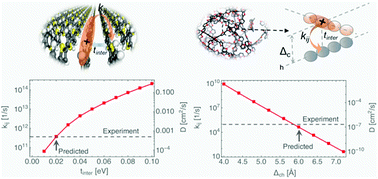Polaron hopping barriers and rates in semiconducting polymers†
Abstract
Conjugated polymers are potential next-generation materials for organic electronic devices. The ability of these materials to transport charges is a key factor limiting their performance. Charge carriers in conjugated polymers are localized by disorder and polaronic effects. Charge transport in these materials is often described by thermally activated hopping, with a rate given by Marcus theory. The polaron hopping activation energy determines the temperature dependence of the Marcus rate. This energy barrier is dictated by the transition state, in which the charge carrier is equally divided between the initial and final locations. The prefactor for the polaron hopping rate is set by the charge tunneling rate between the initial and final locations. We use a tight-binding polaron model, in which charge carriers are stabilized by both nuclear reorganization and polarization of the surrounding dielectric, to compute the activation energy, charge tunneling rate and overall rate constant for intrachain and interchain charge hopping processes in poly(3-hexylthiophene) (P3HT) crystalline lamellae and amorphous melts. Charge transport in these two environments is limited by interchain hopping processes. Both hopping barriers and rates predicted by the model are in good agreement with experiments on a variety of crystalline and amorphous P3HT materials. Qualitatively, the barriers largely depend on how well the transition state is stabilized by polarization effects, and on the hopping integral between the initial and final locations, both of which penalize hopping over longer distances.



 Please wait while we load your content...
Please wait while we load your content...